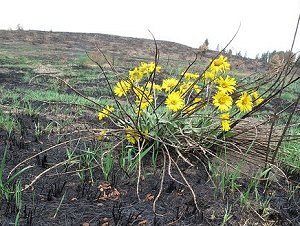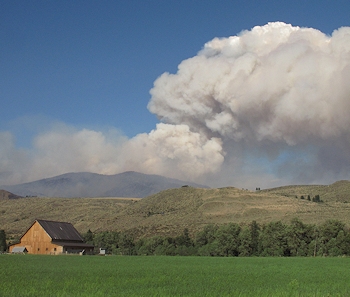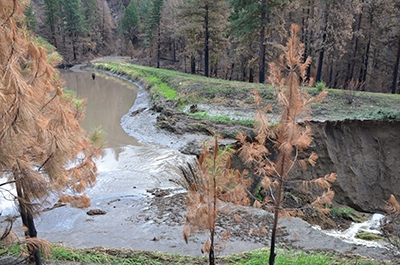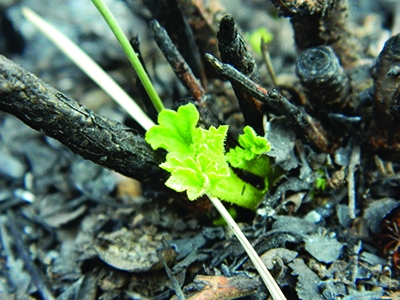Fire Prep & Recovery

Wildfire Preparation, Recovery & Restoration Information
Updated February 11, 2019
Over the past few years, our community has become intimately aware of the inevitability of wildfire in fire-adapted ecosystems such as ours. Through teamwork and partnerships, our community has been working towards recovery from the 2014 Carlton Complex Fire, 2015 Twisp River/Okanogan Complex Fire, and more recent fires; and we have been educating ourselves on the importance of fire preparedness and how to become a community that is "fire adapted".
The sections below provide resources and information regarding fire preparedness, access to information during a wildfire, and short and long-term recovery following wildfire. We will update this resource page with information and news over the coming months. Please see the links above or scroll down for detailed information on each topic. Feel free to let us know what other resources you hope to see from us by emailing us or by calling 509-996-2870.

Fire Preparedness
- Get an official 911 address sign to help firefighters and other emergency services find you.
- Learn what you can do to prepare on the Methow Ready website.
- Make your home and property more Firewise. Creating defensible space, preparing your home for wildfire, and planning your landscape can go a long way to reduce your home ignition risk.
- Read "Wildfire Corner: How a Small Forest Owner Survived the Cold Springs Fire" from the WSU Extension's Forest Stewardship Notes.
- Read “Landscaping in Fire Country: How to Design a Firewise Yard” from the Okanogan Conservation District.
- Read “Landscaping in Fire Country: How the Right Plants may Reduce your Risk from Wildfires” by the Methow Conservancy.
- The Okanogan Conservation District provides free site visits to evaluate the fire hazard to homes and other structures.
- The Washington Department of Natural Resources has staff who will conduct individual, homeowners association or neighborhood site visits to address Firewise practices and wildlife habitat enhancement. Guy Gifford is the WDNR contact for these visit. Ken Bevis, also from the WDNR, is available to meet with small forest landowners to discuss forest management options for wildlife habitat enhancement.
- The Institute for Business & Home Safety released this very helpful handbook for landowners "Wildfire Home Assessment & Checklist" specific to the Pacific Northwest region. It is easy to read and provides a checklist.
- These two webinars have some good photos showing how real fire interacts with various elements of construction: "Material and Design Considerations for Building in Wildfire Prone Areas" and "Before Fire Building Materials & Home Design"
- Check out the “Stewardship Yellow Pages” we here at the Methow Conservancy made. It is a detailed list of individuals, organizations, and businesses that have expertise in a wide variety of areas of land stewardship, include downed trees, forest management, land restoration and more.
- Some thoughts on Managing Forest Riparian Areas for Fire.
- Fuels Reduction and Improved Habitat: Try SLLOPPS (Snags, Logs, Legacy, Openings, Patches, Piles and Shrubs). Read the article in the Forest Stewardship Notes Blog from the WSU Extension office/DNR.
Accessing Information During a Fire
Websites, Facebook pages & radio stations that provide daily information during an active fire include the following:
- Incident Information System (Inciweb) for Washington State
- Okanogan County Emergency Management Facebook page
- Okanogan County Sheriff’s Office Facebook page
- Methow Valley News Facebook page
- Fire District 6 Facebook Page
- Methow Conservancy Facebook page
- Webcams in the Methow Valley
- Methownet.com Bulletin board
- The local radio station, KTRT (FM 97.5) provides fire updates. Tune in or check their facebook page.
- While the fires are burning, smoke and air quality are issues. For up-to-date information on WA and local air quality, go to:

After a Fire
If a wildfire has just occurred, you may be wondering what your land might need.
First, please know our thoughts are with you and we hope to stand with you as you journey through the recovery process. Your property is unique and its habitat type and the severity of the burn will affect the eventual recovery of the vegetation on it. Our staff are available to visit your property for an initial assessment of the potential damage and then share resources that will help you in the restoration of your property. Please call us at 509-996-2870 or email us to schedule a free visit.
Erosion & Flood Risk
- Get flood insurance. Flash floods can affect burned land AND land downhill or downstream from burned areas. If you think you may have a flood risk due to wildfire, talk to your insurance agent about a National Flood Insurance policy (via FEMA but sold by local insurance agents). To learn more about your risk for flooding and how to prepare for floods, visit The National Flood Insurance Program webpage and Myths & Facts About the National Flood Insurance Program and the Okanogan Conservation Districts information about Flood Risk After Fire.
- In areas that were severely burned, soil erosion can be the most immediate consequence and can cause adverse effects on many ecosystems. This document, put out by Colorado State University, provides good information individual landowners can do to reduce erosion.
- This "Step-by-Step Home Insurance Claim Recovery Guide" is helpful for anyone dealing with insurance issues.
- If you need legal assistance with your insurance or understanding forms or just advice, you can contact the Northwest Justice Project at 509-664-5101.

Land Rehabilitation
Betsy Cushman of Methow Recycles can consult with you regarding what to do with your burned materials and debris. Specifically, she can tell you what you can recycle, what can be safely buried, and what should be hauled away as waste.
Our native habitats are adapted to fire and in most circumstances will recover quickly without intervention. This two-page Restoration Handout outlines basic strategies for rehabilitating the types of places that will need help.
Restoring firelines is a major post-fire task. See this one-page "Fireline Rehabilitation Strategies" fact sheet for info and tips. Note that seeding should not been done until fall.
The Okanogan Conservation District (OCD) has a very useful webpage with numerous resources for landowners that have experienced fire activity on their property. Please note that seeding is site specific and we are happy to do a free site visit to give you our seeding recommendations.
The Washington Department of Natural Resources also has staff available to provide technical expertise related specifically to tree damage, merchantability, and recovery actions.
If you are a rancher whose grazing land has been affected by wildfire, you may be eligible for assistance through the Livestock Forage Disaster Program (LFP).

Long Term Recovery
In the years since the Carlton Complex fires raced across much of the Methow Valley, our community has seen countless individuals and organizations helping people transition from crisis to recovery. One of the primary things the Methow Conservancy has been doing to aid in recovery is offer individualized landowner site visits, and ecological, natural resource and agricultural assistance to landowners impacted by the fires and flooding. The Methow Conservancy has also been a constructive participant in the collaborative effort known as Methow Valley Long Term Recovery.
One of the lessons learned from natural disasters around the country is that the success of a community recovering from a disaster depends less upon the type and scale of the disaster itself, and more upon the ability of a community to prepare in advance of a disaster, and then come together early in the disaster to coordinate an initial response and a longer-term recovery process. It’s clear that a cohesive, collaborative effort involving a wide range of non-profit, governmental, business, and faith-based organizations will ensure that a community emerges stronger and more prepared for future events. That is the goal of Methow Valley Long Term Recovery and its Methow Ready program.
Methow Conservancy Executive Director Jason Paulsen has served as President of Methow Valley Long Term Recovery since its formation in 2014 in the wake of the Carlton Complex Fires. Jason will continue to work to ensure that both land restoration and agricultural issues are understood and incorporated into the vast recovery process that includes individual assistance, short-term housing and sustainable rebuilding, infrastructure development, business recovery, and future disaster preparedness. “I continue in this effort in the wake of our most recent fires believing that our Methow Valley community will one day serve as a model for other communities with respect to how we help one another ensure that all sectors of our community, and the families affected, not only recover, but emerge from this effort with greater strength and resiliency,” notes Jason.
You can read about the work accomplished by Methow Valley Long Term Recovery in this Methow Valley News article.